Televised daytime dramas flourished in the 1960s. Housewives were watching in droves, ratings were strong, and a pair of shows that are still standing today made their debuts. Take a look at these interesting Top 10 facts about 1960s soap operas.
1. Soap Operas Go Radio Silent
By the end of 1960, no radio soap operas remained on the air. One of the last shows to go was Ma Perkins, which had had a successful 27-year run. Its final episode was broadcast on November 25, 1960, the day after Thanksgiving that year.
2. A “Dark” Turn
A new soap entered the fray in 1966 that was unlike any of the others. Dark Shadows featured vampires, werewolves, witches, and ghosts. Plus, characters time traveled throughout intricately told plots. The unique format proved popular with younger viewers
3. Headed to Primetime
As daytime soaps grew in popularity, it seemed only natural that they’d eventually cross over to primetime. Peyton Place was the first, debuting on September 15, 1964, on ABC. Starring Dorothy Malone, Ryan O’Neal, and Mia Farrow, the show was loosely based on the 1956 novel of the same name by Grace Metalious.
4. Tackling A Taboo
In 1964, Another World tackled a taboo topic that had never been broached on television before. Heroine Pat Matthews underwent a backstreet abortion, which sadly, left her unable to bear children. The move opened the door for other soaps to tackle the issue as well as other TV firsts.
5. Soap Operas Are Still Standing
Believe it or not, two current daytime dramas actually made their debuts way back in the 1960s. Medical drama General Hospital premiered on April 1, 1963, while Days of our Lives, structured around the close-knit Horton family, bowed on November 8, 1965.
6. A Word from Our Sponsors
By the 1960s, soap operas were the only television genre whose production remained owned and managed by sponsors. Procter and Gamble dominated the field, while other shows had shifted to running ad spots by an array of different advertisers.
7. Ratings Champ and Spinoffs
The most-watched soap in the mid-1960s was As the World Turns on CBS. In fact, it was so successful that the network commissioned a primetime version of the show, Our Private World. Unfortunately, it didn’t connect with viewers as well as its daytime predecessor and was canceled in less than a year.
8. A Stunning Demise
Soap scribe Irna Phillips shook up As the World Turns and gobsmacked viewers when she scripted a devastating car crash in 1962. Young marrieds Jeff (Mark Rydell) and Penny (Rosemary Prinz), the show’s most popular couple, were set for a future of happiness when Phillips abruptly killed off Jeff. Following the episode, CBS switchboards blew up with angry phone calls.
9. Soap Operas As A Platform for Education
Daytime proved that it was more than just a medium for fluff entertainment and made its mark as an educator in the 1960s. It began with its first social-issue storyline, Bert’s (Charita Bauer) diagnosis with uterine cancer on Guiding Light in 1962. She survived, thanks to an early pap smear, and public response was huge.
10. A Peek at a Peak
The number of daily soap operas on television peaked during the 1969-1970 season when there were 19 shows on the air. Leading the ratings pack were the now-defunct As the World Turns and The Edge of Night.

Share this: